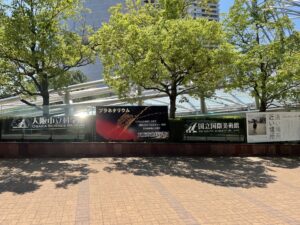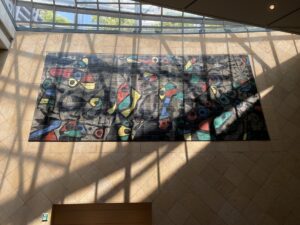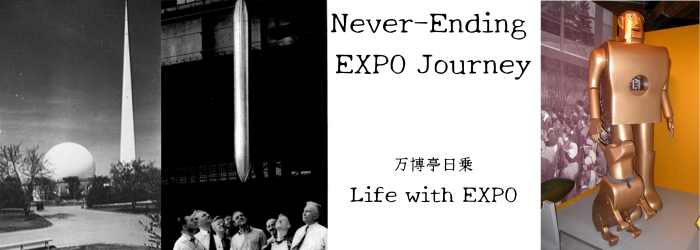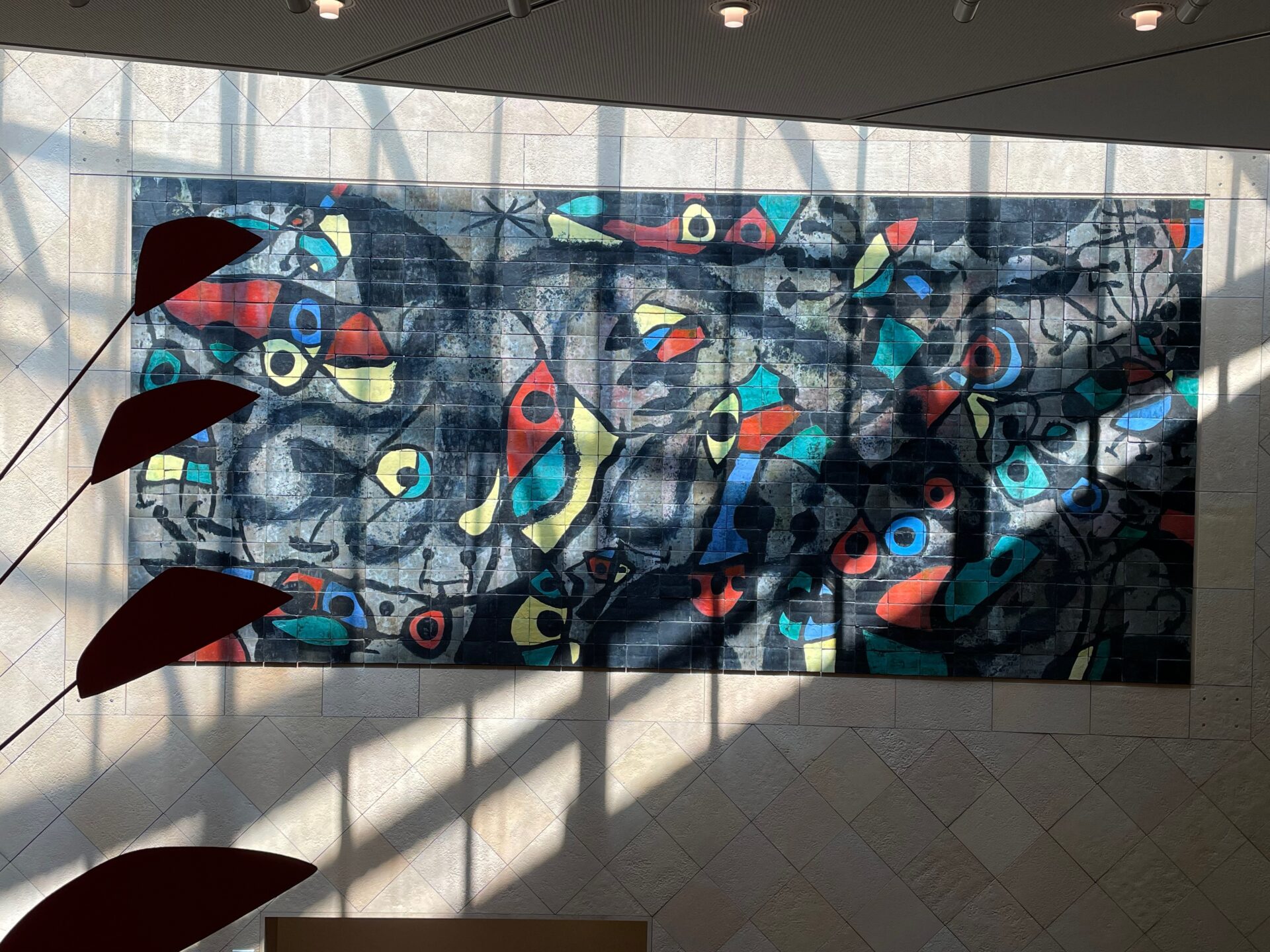Last time, I introduced a story about visiting the “Tower of the Sun” in the Expo ’70 Commemorative Park during an inspection trip to Kansai in the summer of 2022.
This time, I would like to introduce Miró’s porcelain panel mural that I saw at the National Museum of Art, Osaka.

国立国際美術館
The National Museum of Art, Osaka
” Joan Miró and Japan” Exhibition
However, before that, I must touch on the story of the visit to the ” Joan Miró and Japan” Exhibition held at Bunkamura The Museum in Shibuya, Tokyo, which was held from February 11 to April 17, 2022 (sponsored by Bunkamura, Tokyo Shimbun, Fuji Television).
After Bunkamura, the exhibition traveled to the Aichi Prefectural Museum of Art ,and then Toyama Prefectural Museum of Art.
I visited this exhibition at the end of February 2022, a few months before my inspection trip to Kansai.
At that time, almost all art exhibitions had to be reserved in advance due to the influence of the Covid-19 disaster.
At some point, the art exhibition admission fees, which used to be around 1,200 to 1,500 Japanese yen, have soared to around 1,800 to 2,500 yen. It’s a little painful for a heavy visitor like me. However from the organizer’s point of view, the reservation system due to Covid-19, conversely, has to limit the number of visitors. So it will be a big damage in terms of the museums’ revenue. We visitors have to understand, since the number of visitors is limited, museums have to raise the price of admission accordingly.
Did Miró meet Japan because of the Expo?
Well, it’s Miró.
Joan Miró (Previously, he was sometimes called <Hoan Miro> in Spanish reading, but it seems that he himself wanted to be called in Catalan, and recently in Japan his name is pronounced as <Juan Miro >. ) was a painter born in Barcelona, Spain in 1893 and died in Palma de Mallorca in 1983.
In the immediate vicinity of Miró’s birthplace in Barcelona, there was the first Japanese art store in Barcelona, “El Mikado“.
In 1888, Barcelona hosted the World Exposition.
The place called “Ciutadella Park“, which still remains in Barcelona, was the venue, and the number of visitors was not so big, with 2.3 million people. There is also a record that Antoni Gaudí played an active part in this Expo.
By the way, Japan also exhibited works of art at this Expo. Koransha of Arita porcelain also exhibited and won the gold prize.
There was a Japonisme boom in Paris and also a Japonisme boom in Barcelona.
This “El Mikado” dealt in Japanese arts and crafts that were booming at the Barcelona Expo, and Miró must have come into contact with Japanese art at this art dealer near his birthplace. Since then, he has been fascinated by Japan.
It may be said that Miró’s interest in Japan was originally triggered by the 1888 Barcelona World Exposition.
And it was September 21, 1966 that Milo’s first visit to Japan came true.
The first item on display at this exhibition was a work that strongly expressed Miró’s interest in Japan.
The title of the work is “Portrait of Enric Cristófol Ricart”, which depicts Miró’s friend, but on the back of Ricart, Japanese ukiyo-e is drawn in detail.
Two Expos and Miró
And in this exhibition, exhibitions related to ‘Miró and two World Expositions’ were on display. These two Expos are the 1937 Paris Expo and the 1970 Osaka Expo.
1937 Paris World Exposition and Milo
Speaking of the 1937 Paris World Exposition, Picasso is famous for painting “Guernica” for the Spanish Republic Pavilion. It is said that Picasso painted “Guernica” after being shocked by the indiscriminate bombing of the town of Guernica in northern Spain by the Fascist Franco regime. (I will write about this story somewhere else.)
In fact, at that time, Miró also exhibited a work called “The Harvester” at the Spanish Republic Pavilion. “The Harvester” was lost after the Expo ended, but a lithograph titled “Help Spain (Aidez l’Espagne)” was on display at this exhibition. This “Help Spain” was also a work with political meaning as a protest against the Franco regime. Originally drawn as a design for a 1-franc postage stamp to support the Spanish Republic against the Franco regime, it was never used for postage stamps, but it was made into a poster and sold at the Spanish Republic Pavilion at the 1937 Paris Expo.
1970 Osaka Expo and Miró
And another Expo is the 1970 Osaka Expo.
Miró visited Japan this time. Miró’s first trip to Japan was in 1966, but his second was in 1969 for the Osaka Expo. He came to Japan in order to exhibit the ceramic panel mural called “Innocent Laughter” at the “Gas Pavilion” of the Osaka Expo.

ジュアン・ミロ『無垢の笑い』
Joan Miró “Innocent
According to Mr. Kazuho Soeda’s commentary in the ” Miró Exhibition: Dreaming of Japan” catalogue,
*
・・・The (Japan Gas) Association decided on the theme of “Innocent Laughter” and chose Miró as a candidate for the mural. Yasuda, President of Osaka Gas (at the time) , together with Shunro Mitsunaga, Dentsu’s 8th Liaison Bureau Director, and Professor of Kyoto Institute of Technology and interior designer Osamu Higuchi, after long negotiations through Mark Gallery, he persuaded Miró.
*
By the way, as a result of various investigations, this “Mitsunaga Shunro of Dentsu” was found to be the son of the founder of Dentsu, Hoshio Mitsunaga (1866-1945). By the way, I also learned that the kanjis which we usually pronounce ‘Toshiro’ , is called ‘Shunro’.
Also, “Liaison Bureau” was a term unique to advertising companies at the time, and should be understood as “Account Services Division.” Miró was very fond of Shunro Mitsunaga, and it seems that Miró relied on Mitsunaga for many things and consulted him on various matters.
At the time of the Osaka Expo, Shunro was the 4th Liaison Bureau Director of the Osaka branch of Dentsu, in charge of the client Osaka Gas, but was later transferred to Tokyo and became the 8th Liaison Bureau Director in Tokyo, before becoming a Corporate Auditor of Dentsu. He died in 2017 at the age of 97.
By the way, according to the explanation of the Gas Pavilion on the website of Expo ’70 Commemorative Park linked above, there is a description that “the producer of this pavilion was Shunro Mitsunaga.”
Also, in the explanation of the catalog of the same Miró exhibition, we can find the following comments;
*
Joan Gardi Artigas, who arrived in Japan a little earlier, was responsible for the installation of the ceramic wall. Miró, who arrived later, confirmed the situation, then, suggested improvisational painting on the white cement wall of the slope. And he painted pictures on the slope, using hemp palms, bamboo brooms, scrubbing brushes, etc. .
*
It was said that the wall paintings on this slope had been dismantled and destroyed after the Expo, but it was found during the investigation of this exhibition that some of them were kept at Osaka Gas. This is also a great discovery for the Expo history.
After the Expo, “Innocent Laughter“, which was produced for the Gas Pavilion at the 1970 Osaka Expo, was donated to the National Museum of Art, Osaka.
The commentary panel of “Innocent Laughter” at the National Museum of Art, Osaka reads as follows.
*
“Innocent Laughter” 1969, 640 ceramic plates
This gigantic ceramic panel painting was originally displayed in the Gas Pavilion of the Japan Gas Association at the time of the Japan World Exposition held in Osaka in 1970. And this memorable work was donated to the museum after the Expo.
The theme of the Gas Pavilion was “The World of Laughter”, and the audience wandered around the venue, ending with this masterpiece by Miró.
This work is “the last laughter”, or “ultimate laughter”.
*
When it comes to World Expositions, many artists we know today, such as Delacroix, Ingres, and Courbet, have been involved since the latter half of the 19th century.
At the 1970 Osaka World Exposition, which was the first World Exposition held in Japan and Asia, Joan Miró, the world famous master of the art, came to Japan for the Expo project and left behind a variety of dramas.
Now, I am wondering and expecting what kind of pavilion “Gas Pavilion” would be this time.



